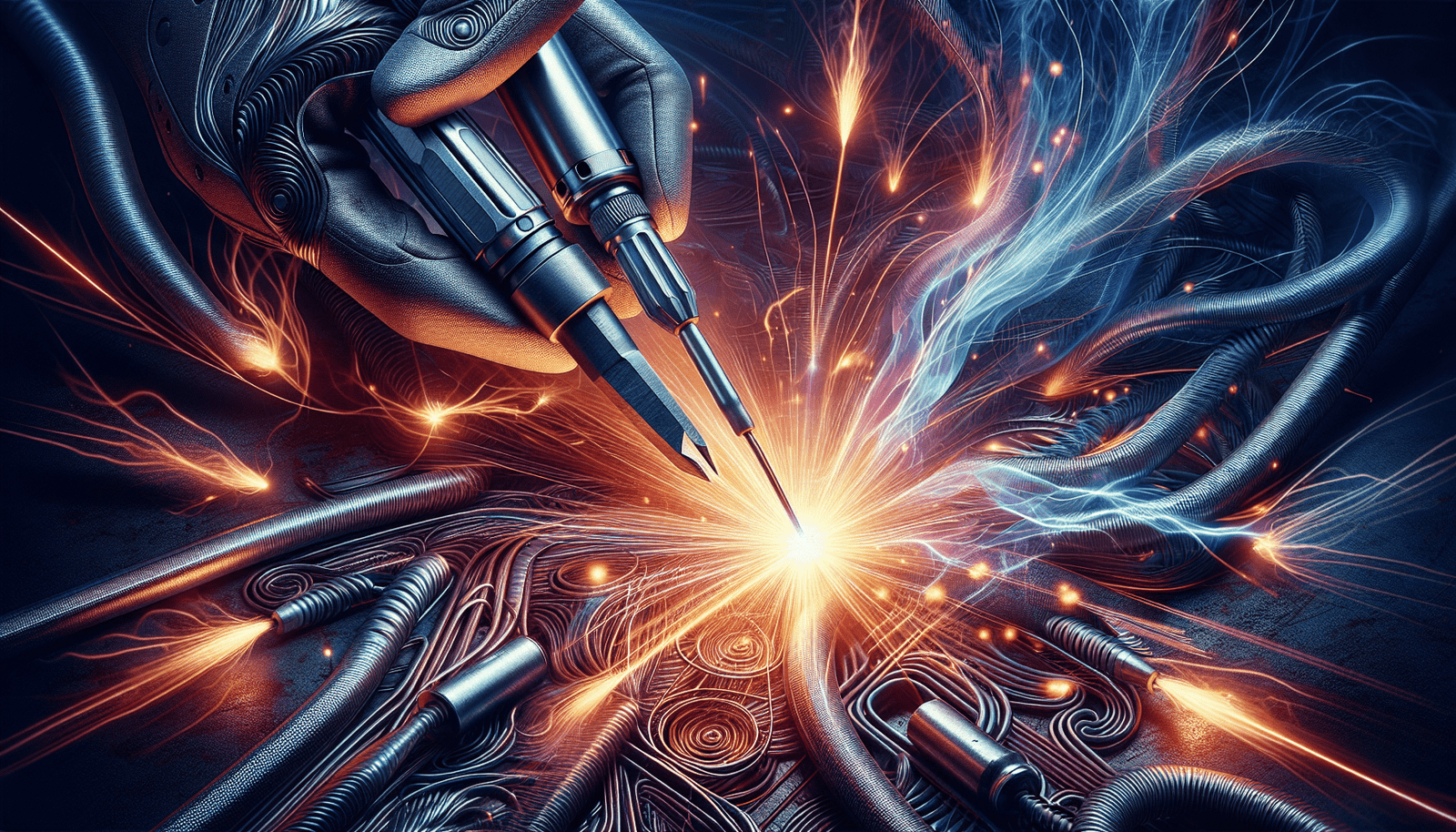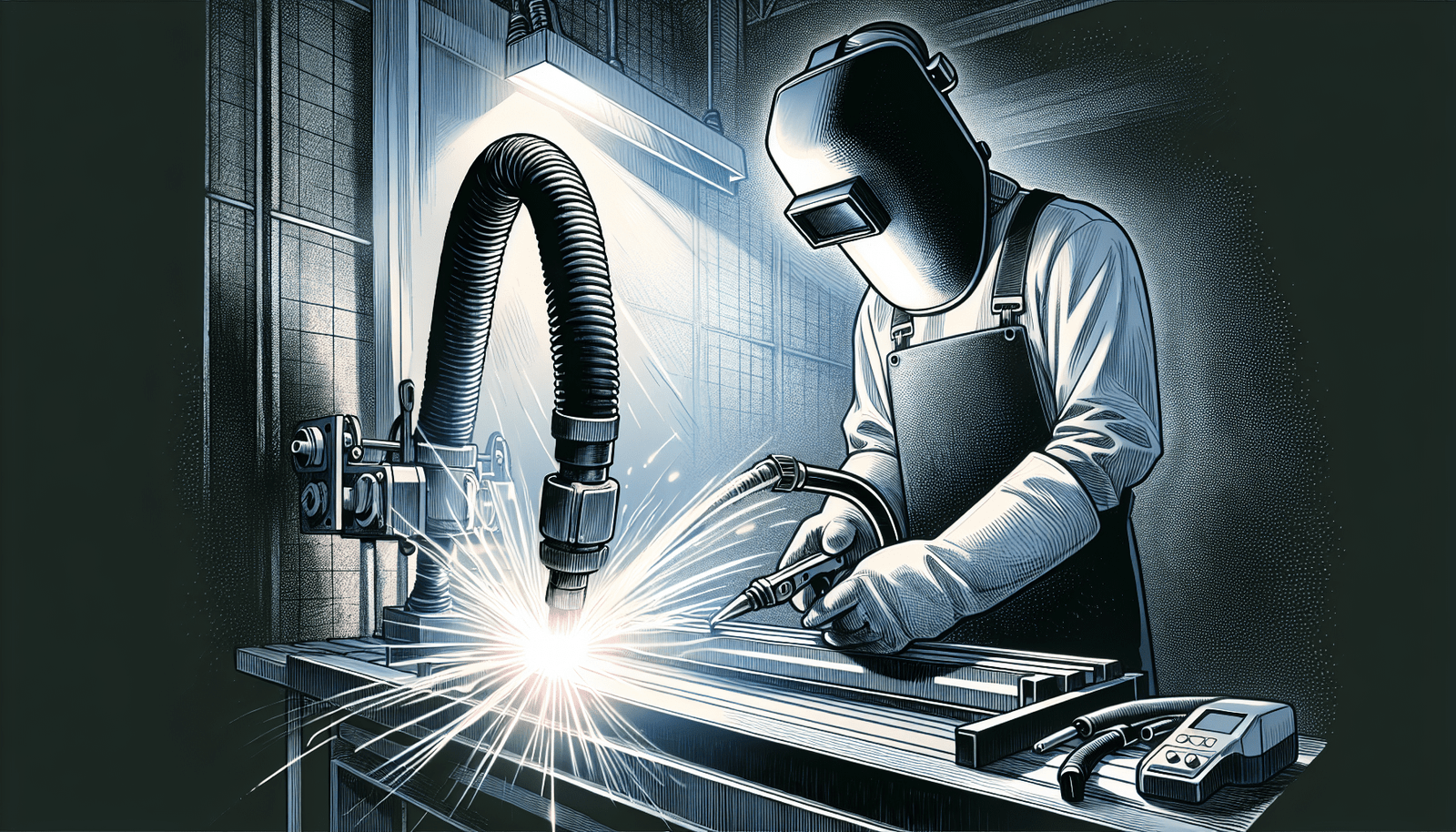Are you looking for some insider tips to help you navigate the world of welding electrode selection? Look no further! In this article, we’ve got you covered with all the information you need to make the best choice for your welding projects. From understanding the different types of electrodes to knowing their applications and characteristics, we’ve got you covered. Whether you’re a seasoned professional or just starting out, these insider tips will ensure you select the right welding electrode every time. So let’s dive in and explore the fascinating world of welding electrode selection together!
Understanding The Welding Electrode
Explanation of what a welding electrode is
A welding electrode is a crucial component in the welding process. It is a metal wire or rod that conducts electricity and is used to provide the heat needed to join two pieces of metal. The electrode plays a vital role in creating an arc between itself and the workpiece, which melts and fuses the metals together. This process is known as arc welding.
The key role of the welding electrode in welding processes
The welding electrode has several important functions in welding processes. First and foremost, it acts as a conductor, allowing the electrical current to pass through and create the welding arc. Secondly, it acts as a filler material, adding additional metal to the weld joint, if necessary. The electrode’s composition also determines the mechanical properties and quality of the weld. It can influence the strength, ductility, and corrosion resistance of the weld, among other characteristics.
Different parts and types of welding electrodes
Welding electrodes consist of three main parts: the core wire, the flux, and the coating. The core wire, typically made of a specific metal alloy, conducts the electrical current and acts as the filler metal. The flux is a cleansing agent that removes impurities from the weld area and forms slag, which helps protect the weld pool. Lastly, the coating provides additional protection and control over the welding process.
There are various types of welding electrodes available, each designed for specific applications and materials. Some common types include:
Mild Steel Electrodes: Used for welding low-carbon steels, these electrodes are versatile and easy to use. They produce welds with good strength and are suitable for a wide range of welding projects.
Stainless Steel Electrodes: Designed for welding stainless steel, these electrodes contain alloying elements that provide corrosion resistance and strength to the weld. They are often used in industries where maintaining the integrity of the weld joint is critical.
Cast Iron Electrodes: These electrodes are specifically formulated for welding cast iron, which is known for its brittleness. They have a unique composition that allows for the gradual transition from high carbon content to lower carbon content during the welding process.
Aluminum Electrodes: These electrodes are used for welding aluminum and aluminum alloys. They have a specialized flux coating that helps remove oxides from the surface, enabling a strong and clean weld.
High-Strength Steel Electrodes: These electrodes are designed for welding high-strength steel, typically used in structural applications. They provide excellent tensile strength and toughness, making them ideal for heavy-duty welding projects.
It is important to select the appropriate type of welding electrode based on the specific requirements of your welding project and the materials being welded.
Identifying Your Welding Needs
The nature of the work to be done
Before selecting a welding electrode, it is crucial to consider the nature of the work to be done. Determine the thickness of the metal being welded, the joint configuration, and any mechanical requirements of the weld. For example, if you are working on thin sheet metal, you may require a welding electrode with lower heat input to prevent distortion or burn-through.
Types of materials to be welded
The types of materials being welded play a significant role in electrode selection. Different metals have unique characteristics, such as conductivity, melting point, and reactivity. Matching the electrode to the base metal ensures optimal performance and a strong weld. For instance, stainless steel electrodes are specifically designed for welding stainless steel, while mild steel electrodes are suitable for welding low-carbon steels.
Workplace conditions and requirements
Consider the conditions and requirements of your workplace when choosing a welding electrode. Factors such as the presence of contaminants, environmental conditions, and safety measures may influence your selection. For example, in outdoor or windy environments, electrodes with a strong arc force and good wind resistance may be necessary to maintain a stable welding process.
Electrode Material
Reviewing different types of electrode materials
Electrodes are available in various materials, with each material offering different properties and characteristics. Understanding the different types of electrode materials can help you select the most appropriate option for your welding needs.
Mild Steel Electrodes: These electrodes are commonly used for welding mild or low-carbon steels. They provide good strength and are versatile in a wide range of applications.
Stainless Steel Electrodes: Designed specifically for welding stainless steel, these electrodes have high chromium and nickel content, providing excellent corrosion resistance and strength to the weld.
Cast Iron Electrodes: Cast iron electrodes have a unique composition that enables them to weld cast iron effectively, overcoming its brittleness. They offer good machinability and heat resistance.
Aluminum Electrodes: These electrodes are used for welding aluminum and aluminum alloys. They have a specialized flux coating to remove oxides and produce clean, strong welds.
High-Strength Steel Electrodes: Designed for welding high-strength steels, these electrodes offer exceptional tensile strength and toughness, making them ideal for structural applications.
Choosing suitable material for your welding needs
To choose the most suitable electrode material for your welding needs, consider the properties required for the weld joint. Factors such as base metal composition, desired mechanical properties, and environmental conditions will all influence your decision. Consulting welding professionals or referring to industry guidelines can provide valuable insights into the best material selection for specific welding applications.
Influence of electrode materials on welding quality
The choice of electrode material can have a significant impact on the quality of the weld. The mechanical properties, corrosion resistance, and overall strength of the weld depend on the compatibility between the electrode material and the base metal. Matching the electrode material to the base metal ensures proper fusion and a high-quality weld joint. Using an incompatible electrode material may result in weak welds, porosity, or improper fusion.
American Welding Society (AWS) Classification System
Understanding the AWS classification system
The American Welding Society (AWS) classification system is a standardized method for identifying and selecting welding electrodes. It provides a comprehensive set of guidelines and codes that help welders choose the appropriate electrode for their specific welding needs. The AWS classification system takes into account various factors, such as electrode material, welding position, and usability, among others.
Decoding AWS numbers for electrode selection
AWS numbers provide essential information about the welding electrode’s characteristics. The numbering system consists of a series of digits and letters. Each digit represents a specific characteristic, such as tensile strength, welding position, or special requirements. Understanding the meaning behind AWS numbers can help you identify suitable electrodes for your welding projects.
For example, a common AWS number format for a mild steel electrode is E6011. The “E” indicates that it is an electrode, and the following digits provide information about its specific properties. In this case, the “60” indicates tensile strength and deposition rate, while the “1” indicates that it can be used in all positions.
Practical use of AWS in identifying suitable electrodes
The AWS classification system simplifies the process of identifying suitable welding electrodes. By understanding the AWS codes and their corresponding properties, you can easily determine which electrodes are appropriate for your specific welding requirements. The AWS classification system helps ensure consistency and quality in welding practices by providing a standardized framework for electrode selection.
Rod Size and Amperage
The correlation between rod size and amperage
The rod size and amperage used in welding are closely correlated. The rod size refers to the diameter of the welding electrode, while amperage measures the electrical current passing through the electrode. As a general rule, larger diameter electrodes require higher amperage levels, while smaller diameter electrodes require lower amperage levels.
Determining the appropriate size and amperage for your task
To determine the appropriate rod size and amperage for your welding task, consider factors such as the thickness of the base metal, joint design, and welding position. Thicker metals generally require larger diameter electrodes and higher amperage to ensure proper penetration and fusion. Welding position, such as flat, horizontal, or vertical, may also influence the selection of rod size and amperage.
It is important to consult welding charts and guidelines provided by electrode manufacturers or welding professionals to ensure accurate rod size and amperage selection for your specific welding application.
Influence of rod size and amperage on welding results
The selection of rod size and amperage directly affects the quality and efficiency of the welding process. Using an inappropriate rod size or amperage can lead to various issues, such as insufficient penetration, excessive heat input, or lack of control over the weld pool. These can result in weak welds, porosity, or distortion.
Matching the rod size and amperage to the specific welding task helps ensure proper heat distribution, penetration, and fusion. This promotes weld integrity and overall welding performance.
Electrode Coating Type
Discussion on different coating types
Electrodes come with different types of coatings, each designed to provide specific benefits during the welding process. The coating materials, which are applied during electrode manufacturing, serve multiple purposes. They influence the characteristics of the welding arc, protect the weld pool and base metal, and control the formation of slag.
Common electrode coating types include:
Rutile (T-1): Rutile coatings are versatile and commonly used for general-purpose welding. They produce a stable arc, provide good deposition rates, and have moderate resistance to moisture.
Cellulosic (E-XX10): Cellulosic coatings are commonly used for welding in outdoor environments due to their excellent arc stability, deep penetration, and high current carrying capacity. However, they have high moisture sensitivity and may produce more smoke during welding.
Basic (E-XX13, E-XX14): Basic coatings produce welds with high ductility and impact resistance. They provide better resistance to moisture, contaminants, and porosity compared to other coating types. They are commonly used for structural welding and work well in all welding positions.
Iron oxide (E-XX24): Iron oxide coatings are used for welding alloys with high nickel content, such as stainless steels. They provide good arc stability and slag control while minimizing the risk of weld cracking.
Role of coating in determining welding arc properties
The coating of an electrode plays a crucial role in determining the properties of the welding arc. Different coatings have varying effects on arc stability, arc force, electrode penetration, and weld appearance. For example, rutile coatings provide a stable arc and good deposition rates, while cellulosic coatings offer deep penetration and high current carrying capacity.
The coating also influences the welding arc’s behavior in different positions, such as flat, horizontal, vertical, or overhead. Some coatings may be more suitable for specific positions, ensuring optimal arc stability and control.
Impact of coating choice on slag, spatter, and welding speed
Choosing the appropriate coating type can significantly impact the welding process and the quality of the weld. The coating affects the formation and properties of the slag, which is a byproduct of the welding process. A good coating can help create a protective slag that shields the weld pool from impurities and atmospheric contamination.
The choice of coating also influences the amount of spatter produced during welding. Spatter refers to the small molten metal droplets that can be formed during the welding process. Certain coatings minimize spatter, resulting in cleaner welds and reduced post-weld clean-up.
The coating type may also affect the welding speed. Some coatings offer better weldability and control, allowing for faster welding speeds and increased productivity.
Stick Welding vs. MIG Welding Electrodes
Comparison between stick welding and MIG welding electrodes
Stick welding, also known as shielded metal arc welding (SMAW), and MIG welding, also known as gas metal arc welding (GMAW), are two commonly used welding processes. Each process requires specific types of electrodes.
Stick welding electrodes (SMAW) are coated rods that are manually fed into the welding joint. They are versatile and can be used in various positions. Stick welding electrodes are suitable for outdoor applications, as they do not require a shielding gas and are less affected by wind or drafts. However, they typically produce more spatter and require more operator skill and control.
MIG welding electrodes (GMAW) are wire electrodes that are fed through a welding gun automatically. They require a shielding gas, usually a mixture of argon and carbon dioxide, to protect the weld pool from atmospheric contamination. MIG welding electrodes offer a higher deposition rate, smoother welds, and less spatter compared to stick welding electrodes. They are well-suited for welding thin materials and large production runs.
Assessing your projects to choose between the two
When choosing between stick welding and MIG welding electrodes, consider the nature of your projects. Stick welding electrodes are more versatile and can be used in various welding positions, making them suitable for a wide range of applications. They are often the preferred choice for outdoor and field welding.
MIG welding electrodes are commonly used in industrial settings, especially for applications that require high-speed and efficient welding. They offer smoother welds, higher deposition rates, and are more suitable for thin materials. MIG welding is often favored for automotive, fabrication, and manufacturing projects.
It is essential to assess the specific requirements and conditions of your projects to determine whether stick welding or MIG welding electrodes are more appropriate.
Understanding their respective strengths and weaknesses
Both stick welding and MIG welding electrodes have their strengths and weaknesses. Stick welding electrodes offer versatility, ease of use, and suitability for outdoor applications. They are often preferred for repair work, construction, and maintenance tasks.
MIG welding electrodes provide higher efficiency, smoother welds, and better control over the welding process. They are suitable for welding thin materials, large production runs, and applications that require high-speed welding. However, MIG welding requires more complex equipment and training.
Understanding the strengths and weaknesses of each type of electrode helps you make an informed decision based on your specific welding requirements.
Electrode Storage and Handling
Importance of proper storage and handling of electrodes
Proper storage and handling of electrodes are crucial for maintaining their performance and preventing potential issues during the welding process. Electrodes are susceptible to moisture and contaminants, which can affect their coating, arc stability, and overall weld quality. By storing and handling electrodes correctly, you can ensure their integrity and maximize their lifespan.
Best practices for electrode storage
Here are some best practices for storing electrodes:
Keep electrodes in a dry environment: Moisture is the primary enemy of welding electrodes. Store them in a dry and temperature-controlled environment to prevent moisture absorption, which can lead to coating degradation and welding defects.
Use appropriate storage containers: Store electrodes in air-tight containers or resealable bags to protect them from moisture and contaminants. Alternatively, use electrode storage ovens designed specifically for electrode preservation.
Follow proper temperature guidelines: Some electrodes, particularly low-hydrogen types, require specific temperature conditions during storage. Make sure to adhere to the manufacturer’s guidelines regarding temperature storage requirements.
Rotate stock: Use the “first in, first out” method when using electrodes to ensure older stock is used before newer stock. This helps prevent the storage of expired or compromised electrodes.
Tips on how to handle electrodes to prevent damage or accidents
Proper handling of electrodes is equally important to prevent damage and accidents. Consider the following tips:
Handle electrodes with clean and dry gloves: Contaminants on gloves or hands can transfer onto the electrode’s coating, affecting its performance. Always wear clean and dry gloves when handling electrodes.
Avoid dropping or mishandling electrodes: Dropping electrodes can cause damage to the coating, compromising their integrity and leading to welding defects. Handle electrodes with care and avoid unnecessary impacts or rough handling.
Inspect electrodes before use: Check the condition of electrodes before use. Look for any signs of damage, such as cracks, chipping, or coating degradation. Discard any electrodes that are visibly compromised.
Use electrode holders correctly: When using stick welding electrodes, ensure that the electrode holder is properly secured and in good condition. Loose holders can result in poor electrical contact and unstable arcs.
By following these practices, you can maintain the quality and performance of your welding electrodes and maximize their effectiveness during the welding process.
Specialized Electrodes
Understanding specialized electrodes
Specialized electrodes are designed for specific welding applications or specialized requirements. These electrodes offer unique characteristics and properties tailored to address specific challenges in welding. While they may not be suitable for general-purpose welding, they excel in specialized industries and projects.
Common types of specialized electrodes include:
Hardfacing Electrodes: Hardfacing electrodes are used for surfacing and rebuilding worn-out surfaces, providing exceptional wear resistance. They are commonly used in mining, construction, and agricultural industries.
Nickel Electrodes: Nickel electrodes are specifically formulated for welding nickel and nickel alloys. They offer excellent corrosion resistance and can withstand high temperatures, making them suitable for the chemical and petrochemical industries.
Tungsten Electrodes: Tungsten electrodes are used in tungsten inert gas (TIG) welding. They have high melting points and provide good arc stability, making them ideal for precise and high-quality welds.
Common use cases for specialized electrodes
Specialized electrodes find applications in various industries and projects. Hardfacing electrodes, for example, are widely used in the mining industry to protect equipment and machinery from wear and abrasion. Nickel electrodes are commonly employed in the chemical and petrochemical industries, where corrosion resistance is of utmost importance.
Tungsten electrodes are essential components in TIG welding, where high-quality welds and control are required. They are often used in industries such as aerospace, automotive, and precision engineering.
Understanding the specific requirements of your welding project can help you determine if the use of specialized electrodes is necessary and beneficial.
Tips to decide when to use them
Here are some tips to help you decide when to use specialized electrodes:
Assess specific requirements: Evaluate the specific requirements of your welding project. Consider factors such as mechanical properties, corrosion resistance, environmental conditions, and unique challenges. Identify if the specialized properties of certain electrodes are necessary to meet those requirements effectively.
Consult industry experts: Seek advice from welding professionals or industry experts who specialize in the specific field or application. They can provide valuable insights and recommendations based on their experience and expertise.
Evaluate cost versus benefit: Consider the cost implications of using specialized electrodes. Assess whether the benefits in terms of improved performance, efficiency, or longevity outweigh the additional cost. Perform a cost-benefit analysis to make an informed decision.
Choosing to use specialized electrodes can significantly enhance the quality and effectiveness of your welding projects. By carefully evaluating the requirements and consulting experts, you can determine whether specialized electrodes are the right choice for your specific applications.
Safety Precautions
Key safety tips when selecting and using electrodes
While selecting and using electrodes, it is crucial to prioritize safety. Here are some key safety tips to keep in mind:
Follow manufacturer guidelines: Always follow the manufacturer’s guidelines and recommendations for electrode selection, storage, and usage. The manufacturer’s instructions provide valuable safety information specific to the electrode type.
Understand safety data sheets (SDS): Safety data sheets provide information on the potential hazards associated with specific electrodes, including handling precautions and emergency response measures. Familiarize yourself with the SDS of the electrodes you are using.
Use proper ventilation: Welding fumes and gases can be hazardous. Make sure the work area is well-ventilated, especially if you are working indoors. Use local exhaust ventilation or wear appropriate respirators to minimize your exposure to welding fumes.
Protect against arc radiation: Welding arcs emit intense light and radiation that can be harmful to your eyes and skin. Wear appropriate protective gear, including welding helmets with proper shade filters, safety glasses or goggles, and flame-resistant clothing.
Potential hazards and how to mitigate them
Welding electrodes pose several potential hazards that should be mitigated. Some common hazards associated with welding electrodes include:
Fumes and Gases: Welding fumes and gases contain toxic substances that can be harmful if inhaled. Ensure proper ventilation, use respiratory protection, and work in well-ventilated areas to reduce exposure.
Electrical Hazards: Welding involves working with electrical currents, which can pose hazards. Inspect and maintain welding equipment, wear appropriate personal protective equipment (PPE), and follow safe electrical practices to prevent electric shock or electrocution.
Fire and Explosions: Welding generates sparks, heat, and molten metal, which can lead to fire hazards if proper precautions are not taken. Keep a fire extinguisher nearby, remove flammable materials from the work area, and follow fire safety protocols.
Ultraviolet (UV) Radiation: Welding arcs emit UV radiation that can cause eye and skin damage. Wear appropriate eye protection, such as welding helmets with the correct shade filters, and use protective clothing to minimize UV exposure.
Mitigating these hazards involves following safety protocols, using proper PPE, and maintaining a safe work environment. Regular training and staying up-to-date with safety practices are essential for minimizing risks associated with welding electrodes.
Proper protective equipment to use when welding
When welding, it is crucial to use the appropriate protective equipment to ensure personal safety. Some essential protective equipment includes:
Welding Helmet: A welding helmet with a proper shade filter protects your eyes from the intense light and UV radiation emitted during welding.
Safety Glasses or Goggles: Safety glasses or goggles with side shields safeguard your eyes from flying particles, sparks, and debris.
Respiratory Protection: Depending on the materials being welded and the ventilation conditions, respiratory protection may be necessary to protect against welding fumes and gases. Use masks or respirators appropriate for welding applications.
Flame-Resistant Clothing: Wear flame-resistant clothing to protect your skin from sparks, splatter, and heat. Avoid wearing synthetic materials that may melt during welding.
Welding Gloves: Welding gloves provide hand protection from heat, sparks, and molten metal. Choose gloves made from flame-resistant materials, such as leather or heavy-duty fabric.
Welding Apron or Jacket: A welding apron or jacket made from flame-resistant materials provides additional protection for your body.
By wearing the proper protective equipment, you can significantly reduce the risk of injuries and ensure a safe welding environment.
In summary, understanding welding electrode types, their characteristics, and the influence of various factors on electrode selection is essential for successful welding projects. By considering the nature of the work, materials being welded, workplace conditions, and safety precautions, you can choose the most suitable electrode and ensure safe and efficient welding operations.



